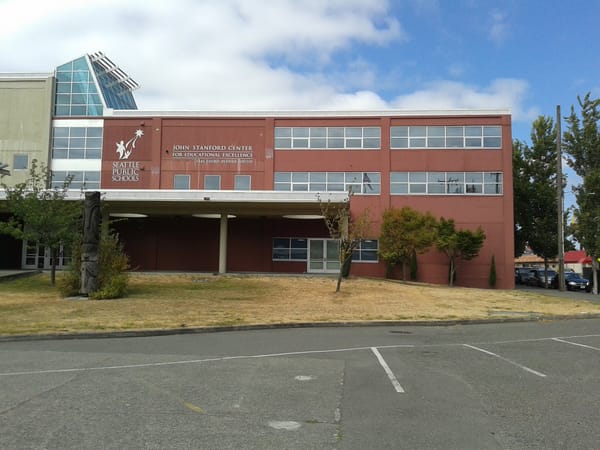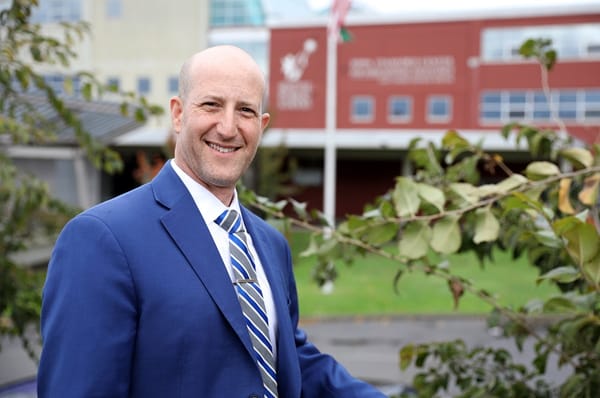Issue 4 -- It's Time for SPS To Lead on Limiting Screens in the Classroom

In this issue: Emily Cherkin takes a look at SPS policies about technology use in schools, and raises key questions that SPS leaders must answer.
by Emily Cherkin
On November 19, 2025, staff members at Seattle School District presented to Board Directors and the public about technology use in Seattle Public Schools. Before the meeting, I reviewed the slides uploaded to the Board Agenda and sent an email to staff as I was concerned the posted materials did not address many of the questions I had about how the district handles screens– both personal and those provided by the district.
I have been writing, speaking, testifying, and organizing around technology use in Seattle schools and beyond for many years. My first public testimony in Seattle was in May of 2019 to express my concerns about the adoption of the all-digital Amplify Science curriculum.
Between May 2019 and today, of course, remote learning flooded our home lives with school-issued technology during the pandemic, and while digital connectivity was the lifeboat we needed to keep students connected to their teachers at the start of the pandemic, a lifeboat is never intended to be used long term, yet the technology doled out to our children during the pandemic remains in classrooms today, now with access to GenAI products.
Wednesday’s board meeting ran nearly five hours, with the presentation and work session not starting until nearly 8 PM, leaving directors little time to address concerns and ask questions. However, Director Evan Briggs has been very responsive to my concerns about technology use in schools and she raised excellent questions in the short time allotted, as did two of the student board directors. It is worth watching. (You can watch the whole meeting on YouTube.)
Media coverage of the board meeting has focused on the possibility of a districtwide policy regarding cell phones. It’s good to see SPS considering this, though specific questions remain unanswered (see item #4 below). It’s not just phones that need attention, however. Concerns about the use of AI in school, as well as student data privacy protection, also need to be addressed by the community, the board, and SPS administration working together.
Below is the list of questions I sent to school district staff and board directors before the November 19th presentation, in the hopes they would address at least some of these concerns.
These are four areas of concern relating to technology and children that I am hoping the district will address:
- GenAI and LLM use in Seattle Public Schools
- Are teachers expected or encouraged to use AI to assess student writing? Are students and parents informed when this happens?
- What independent, evidence-based research does the district rely on to provide developing children access to LLMs? Where can parents view this research?
- What specifically is the district doing to ensure that children are not accessing harmful content via such platforms?
- How does the district reconcile the use of AI tools when it directly threatens to undermine Board Resolution No. 2020/21-18, the district’s Clean Energy Resolution?
- Can the district make available to the public copies of the lessons students receive about the environmental impacts of AI on climate change?
- How does the district determine how many children can be harmed via EdTech platforms before the district will make changes?
- Technology Education (vs. Educational Technology) in Seattle Public Schools
- Children need education about technology (tech education). How does the district teach technology skills vs. relying on educational technology (such as 1:1s and digital curriculum)?
- Where can parents view copies of the lessons that children receive about technology education?
- Is the curriculum that the district uses to teach technology education funded by technology companies?
- As more parents seek an option to refuse EdTech products, GenAI, and 1:1 devices, what is the district’s plan for providing non-digital access to the curriculum without further burdening teachers?
- Instead of investing in surveillance technology products like GoGuardian, has the district considered instead removing the problematic 1:1 devices in the first place? If not, why not?
- Data privacy concerns related to PowerSchool products used by Seattle Public Schools
- In the Main Services Agreement the district has with PowerSchool, Section 3.2 is really broad. What uses within this does SPS consent to?
- Is SPS providing its explicit written consent to allow PowerSchool to use “SPS data” for its commercial benefit?
- How is the district acquiring informed parental consent for each unique EdTech product or platform used by students?
- What, beyond trusting PowerSchool’s assurances, gives the district confidence that student data is actually de-identified? What is the district doing to ensure that it is?
- Per the Executive Approval Form for PowerSchool it appears SPS uses Unified Insights, which requires student data to develop predictions, and which allows PowerSchool to upsell its customers. How is this not monetization of student data?
- The lack of a district-wide phone ban
- The proposed “Next Steps” in the presentation slides states “Fall ‘25 Additional Engagement.” What does that look like? With whom? When?
- What is the district hoping to learn from this “additional engagement” and how might what they hear shape the direction of future policy?
- Neither Board Policies 2022 nor 2023 mentions “phones.” Do these policies need to be updated to reflect current realities?
- Staff refer to an “emerging districtwide direction” on phone policies. That’s great. What is the justification for potentially allowing high school students access to phones during class?
- For directors interested in learning more about Phone-Free Schools, please visit phonefreeschoolsmovement.org.
With new leadership entering the district, it is my hope that those in charge of providing internet-connected devices to children will think critically and thoughtfully about the efficacy, safety, and legality of doing so. Maintaining the status quo threatens the safety, health, and well-being of the most vulnerable members of our community. I hope Seattle finds the courage to be a leader on these issues.
Emily Cherkin, M.Ed. attended Seattle Public Schools in the 1980s and currently has a child in middle school in the district. Emily writes about EdTech and more at First Fish Chronicles on Substack. You can learn more about her work here.



